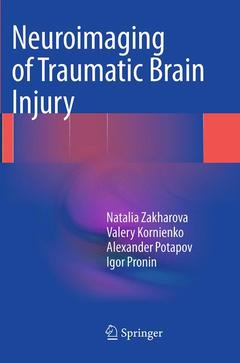Description
Neuroimaging of Traumatic Brain Injury, Softcover reprint of the original 1st ed. 2014
Authors: Zakharova Natalia, Kornienko Valery, Potapov Alexander, Pronin Igor
Language: English
Subjects for Neuroimaging of Traumatic Brain Injury:
52.74 €
In Print (Delivery period: 15 days).
Add to cart
Neuroimaging of Traumatic Brain Injury
Publication date: 08-2016
Support: Print on demand
Publication date: 08-2016
Support: Print on demand
Approximative price 52.74 €
In Print (Delivery period: 15 days).
Add to cart
Neuroimaging of Traumatic Brain Injury
Publication date: 04-2014
159 p. · 15.5x23.5 cm · Hardback
Publication date: 04-2014
159 p. · 15.5x23.5 cm · Hardback
Description
/li>Contents
/li>Comment
/li>
The main purpose of this book is to present emerging neuroimaging data in order to define the role of primary and secondary structural and hemodynamic disturbances in different phases of traumatic brain injury (TBI) and to analyze the potential of diffusion tensor MRI, tractography and CT perfusion imaging in evaluating the dynamics of TBI. The authors present a new MRI classification of brain stem and hemispheric cortical/subcortical damage localization that is of significant prognostic value. New data are provided regarding the pathogenesis and dynamics of diffuse and focal brain injuries and qualitative and quantitative changes in the brain white matter tracts. It is shown that diffuse axonal injury can be considered a clinical model of multidimensional ?split brain? with commissural, association and projection fiber disorders. The book will be of interest for neuroradiologists, neurosurgeons, neurologists and others with an interest in the subject.
Clinical and prognostic value of neuroimaging in traumatic brain injury.- Clinical evaluation and neuroimaging technologies.- Neuroimaging classification of traumatic brain injury.- Dynamic study of white matter fiber tracts after traumatic brain injury.- Mapping of cerebral blood flow in focal and diffuse brain injury.- Dynamics of hemispheric and brain stem cerebral blood flow.- Conclusion.
Presents novel neuroimaging data elucidating the role of structural and physiological disturbances in different phases of traumatic brain injury (TBI) Analyzes the potential of diffusion tensor MRI, tractography and CT perfusion imaging in evaluating the dynamics of TBI Presents a new MRI classification of prognostic significance
© 2024 LAVOISIER S.A.S.
These books may interest you

Traumatic Brain Injury, Part I 280.40 €



